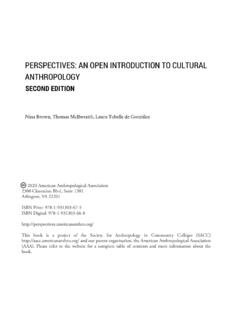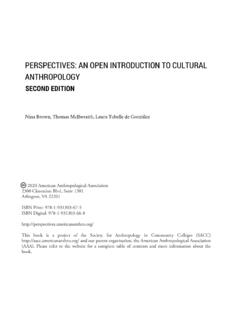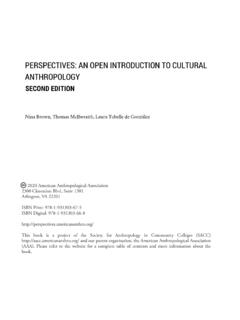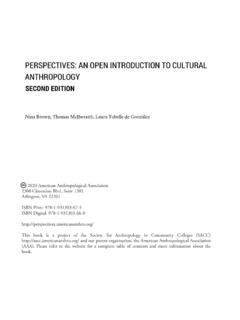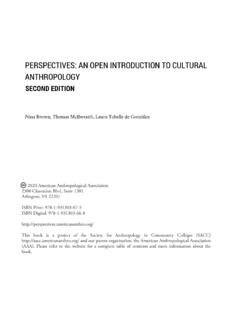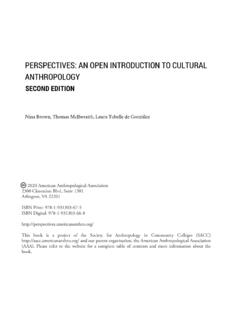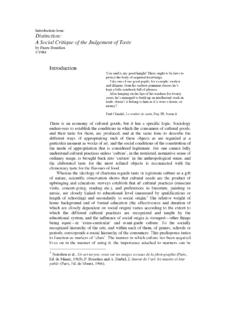Transcription of Perspectives: An Open Introduction to Cultural Anthropology
1 PERSPECTIVES: AN OPEN Introduction TO Cultural Anthropology Nina Brown, Thomas McIlwraith, Laura Tubelle de Gonz lez 2020 American Anthropological Association2300 Clarendon Blvd, Suite 1301 Arlington, VA 22201 ISBN Print: 978-1-931303-67-5 ISBN Digital: 978-1-931303-66-8 book is a project of the Society for Anthropology in Community Colleges (SACC) and our parent organization, the American Anthropological Association (AAA). Please refer to the website for a complete table of contents and more information about the EDITIONP erspectives: An Open Introduction to Cultural Anthropology by Nina Brown, Thomas McIlwraith, Laura Tubelle de Gonz lez is licensed under a Creative Commons Attribution-NonCommercial International License, except where otherwise noted.
2 Under this CC BY-NC copyright license you are free to: Share copy and redistribute the material in any medium or format Adapt remix, transform, and build upon the material Under the following terms: Attribution You must give appropriate credit, provide a link to the license, and indicate if changes were made. You may do so in any reasonable manner, but not in any way that suggests the licensor endorses you or your use. NonCommercial You may not use the material for commercial purposes. 7 7 POLITICAL Anthropology : POLITICAL Anthropology : A CROSS- Cultural A CROSS- Cultural COMPARISON COMPARISON Paul McDowell, Santa Barbara City College Learning Objectives Learning Objectives Identify the four levels of socio- Cultural integration (band, tribe, chiefdom, and state) and describe their characteristics.
3 Compare systems of leadership in egalitarian and non-egalitarian societies. Describe systems used in tribes and chiefdoms to achieve social integration and encourage connections between people. Assess the benefits and problems associated with state-level political organizations. Evaluate the extent to which the Islamic State meets the formal criteria for a state-level political organization. All cultures have one element in common: they somehow exercise social control over their own mem-bers. Even small foraging societies such as the Ju/ hoansi or !Kung, the Inuit (or Eskimo ) of the Arctic north, and aboriginal Australians experience disputes that must be contained if inter-personal conflicts are to be reduced or eliminated.
4 As societies become more complex, means of control increase accord-ingly. The study of these means of control are the subject of political Anthropology . BASIC CONCEPTS IN POLITICAL Anthropology 148 Like the invisible hand of the market to which Adam Smith refers in analyzing the workings of cap-italism, two forces govern the workings of politics: power the ability to induce behavior of others in specified ways by means of coercion or use or threat of physical force and authority the ability to induce behavior of others by Extreme examples of the exercise of power are the gulags (prison camps) in Stalinist Russia, the death camps in Nazi-ruled Germany and Eastern Europe, and so-called Supermax prisons such as Pelican Bay in California and the prison for enemy combatants in Guantanamo Bay, Cuba, by the United States.
5 In all of these settings, prisoners comply or are punished or executed. At the other extreme are most forager societies, which typically exercise authority more often than power. Groups in those societies comply with the wishes of their most persuasive members. In actuality, power and authority are points on a continuum and both are present in every society to some degree. Even Hitler, who exercised absolute power in many ways, had to hold the Nuremberg ral-lies to generate popular support for his regime and persuade the German population that his leadership was the way to national salvation. In the Soviet Union, leaders had a great deal of coercive and physical power but still felt the need to hold parades and mass rallies on May Day every year to persuade peo-ple to remain attached to their vision of a communal society.
6 At the other end of the political spectrum, societies that tend to use persuasion through authority also have some forms of coercive power. Among the Inuit, for example, individuals who flagrantly violated group norms could be punished, including by related concept in both politics and law is legitimacy: the perception that an individual has a valid right to leadership. Legitimacy is particularly applicable to complex societies that require centralized decision-making. Historically, the right to rule has been based on various principles. In agricultural states such as ancient Mesopotamia, the Aztec, and the Inca, justification for the rule of particular indi-viduals was based on hereditary succession and typically granted to the eldest son of the ruler.
7 Even this principle could be uncertain at times, as was the case when the Inca emperor Atahualpa had just defeated his rival and brother Huascar when the Spaniards arrived in Peru in many cases, supernatural beliefs were invoked to establish legitimacy and justify rule by an elite. Incan emperors derived their right to rule from the Sun God and Aztec rulers from Huitzilopochtli (Hummingbird-to-the-Left). European monarchs invoked a divine right to rule that was reinforced by the Church of England in Britain and by the Roman Catholic Church in other countries prior to the Reformation. In India, the dominance of the Brahmin elite over the other castes is justified by karma, cumulative forces created by good and evil deeds in past lives.
8 Secular equivalents also serve to justify rule by elites; examples include the promise of a worker s paradise in the former Soviet Union and racial purity of Aryans in Nazi Germany. In the United States and other democratic forms of government, legitimacy rests on the consent of the governed in periodic elections (though in the United States, the incoming president is sworn in using a Christian Bible despite alleged separation of church and state). In some societies, dominance by an individual or group is viewed as unacceptable. Christopher Boehm (1999) developed the concept of reverse dominance to describe societies in which people rejected attempts by any individual to exercise They achieved this aim using ridicule, criticism, disobedience, and strong disapproval and could banish extreme offenders.
9 Richard Lee encountered this phenomenon when he presented the !Kung with whom he had worked over the preceding year with a fattened Rather than praising or thanking him, his hosts ridiculed the beast as scrawny, ill fed, and probably sick. This behavior is consistent with reverse dominance. Even in societies that emphasize equality between people, decisions still have to be made. Sometimes particularly persuasive figures such as headmen make them, but persuasive figures who lack formal power are not free to make decisions without coming to a consensus with their fellows. To reach such 149consensus, there must be general agreement. Essentially, then, even if in a backhanded way, legitimacy characterizes societies that lack institutionalized leadership.
10 Another set of concepts refers to the reinforcements or consequences for compliance with the direc-tive and laws of a society. Positive reinforcements are the rewards for compliance; examples include medals, financial incentives, and other forms of public recognition. Negative reinforcements punish noncompliance through fines, imprisonment, and death sentences. These reinforcements can be identi-fied in every human society, even among foragers or others who have no written system of law. Reverse dominance is one form of negative reinforcement. LEVELS OF SOCIO- Cultural INTEGRATION If cultures of various sizes and configurations are to be compared, there must be some common basis for defining political organization. In many small communities, the family functions as a political unit.

